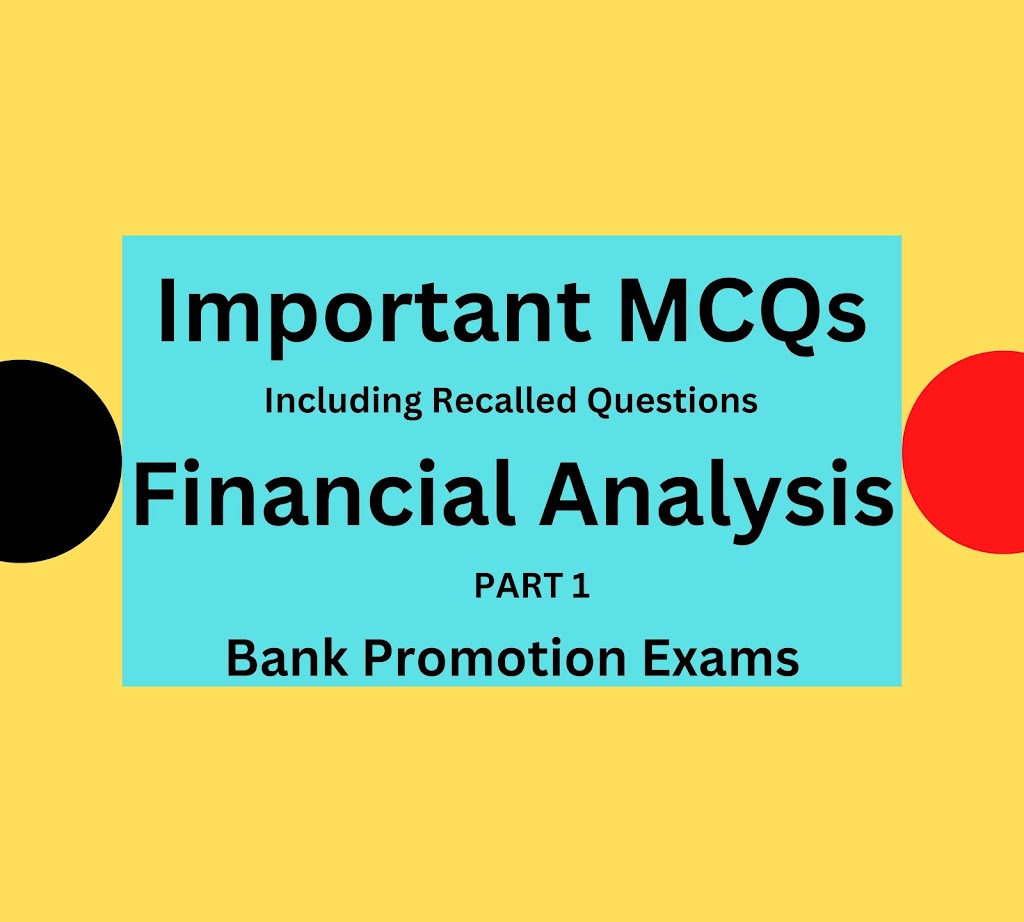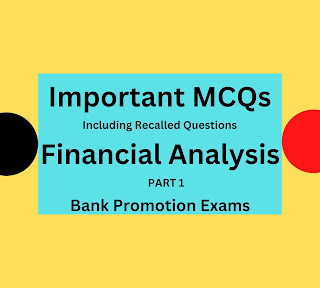Multiple Choice
Questions on Financial
Analysis for Bank Promotion Exams (Part 1)
1. Balance sheet is a
statement of assets and liabilities or statement of sources and uses
(a) as on a date
(b) as on 31st March
(c) for 12 months
(d) for a particular period
The correct answer is
option (a) as on a date
2. Assets can be
represented as
(a) uses of funds
(b) sources of funds
(c) both (a) and (c) above
(d) none of these
The correct answer is
option (c) both (a) and (c) above
3. Liabilities can be
represented as
(a) sources of funds
(b) uses of funds
(c) both (a) and (c) above
(d) none of these
The correct answer is
option (c) both (a) and (c) above
4. Current assets are
defined as
(a) assets which are expected to be consumed or
converted into cash within the operating cycle
(b) assets which are expected to be consumed or
converted into cash within one year
(c) either (a) or (b), whichever is earlier
(d) either (a) or (b), whichever is later
The correct answer is
option (d) either (a) or (b), whichever is later
5. Fixed assets are defined as
(a) assets which are fixed to the land
(b) assets which have a fixed value
(c) assets which are acquired for production and
are not meant for sale
(d) assets which cannot
be sold easily
The correct answer is
option (c) assets which are acquired for production and are not meant for sale
6. Term liabilities are
one
(a) which are to be met within one year from the
date of balance sheet
(b) which are payable beyond one year from the
date of balance sheet
(c) which were raised for more than one year
(d) which are not payable immediately
The correct answer is
option (b) which are payable beyond one year from the date of balance sheet
7. Current Liabilities are those liabilities
(a) which are payable within one year
(b) which are expected to be met from the
proceeds of current assets
(c) which are payable
after one year
(d) both (a) & (b)
above
The correct answer is
option (d) both (a) & (b) above
8. Which of the following is not classified as
current asset?
(a) stocks
(b) prepaid expenses
(c) pre-operative expenses
(d) book debts
The correct answer is
option (c) pre-operative expenses
9. Which of the following is classified as
intangible or fictitious asset?
(a) Goodwill
(b) Preliminary expenses
(c) Accumulated losses
(d) All of these
The correct answer is
option (d) All of these
10. Which of the following is a current
liability?
(a) Sundry creditors
(b) Borrowings from banks
(c) Provision for tax
(d) All of these
The correct answer is
option (d) All of these
11. Debtors which are
older than 6 months are to be classified as
(a) Current Assets
(b) Intangible Assets
(c) Non-Current Assets
(d) Fixed Assets
The correct answer is
option (c) Non-Current Assets
12. Instalments of term loan falling due within a
year are treated as
(a) current liability
(b) current asset
(c) non-current assets
(d) term liability
The correct answer is
option (a) current liability
13 sales minus cost of
sales is referred to as:
(a) operating profit
(b) net profit
(c) profit before tax
(d) gross profit
The correct answer is
option (d) gross profit
14. Operating profit is
arrived at by
(a) reducing administrative, general and selling
expenses from gross profit
(b) adding back
depreciation to gross profit
(c) adding back
depreciation and interest to net profit
(d) adding back Interest expenses to gross profit
The correct answer is
option (a) reducing administrative, general and selling expenses from gross
profit
15. Cash profit Is
(a) gross profit before
depreciation
(b) net profit after
depreciation
(c) net profit before
depreciation
(d) gross profit after
depreciation
The correct answer is
option (c) net profit before depreciation
16. Cash loss is
(a) gross loss before
depreciation
(b) net loss after
depreciation
(c) net loss before
depreciation
(d) gross loss after
depreciation
The correct answer is
option (c) net loss before depreciation
17. Tangible net worth means:
(a) Paid up capital and reserves minus intangible
assets
(b) Paid up capital and reserves minus instalment
of term loan payable within one year
(c) net worth minus
investment in fixed assets
(d) Net worth minus
current liabilities
The correct answer is
option (a) Paid up capital and reserves minus intangible assets
18. The term ‘Liquid
surplus ‘or ‘Net working capital ‘refers to
(a) total investment in current assets
(b) excess of current liabilities over current
assets
(c) excess of current assets over current liabilities
(d) excess of capital plus free reserves over
term
The correct answer is
option (c) excess of current assets over current liabilities
19. Net working capital will be positive when
(a) current assets are more than current
liabilities
(b) current liabilities are more than current
assets
(c) current ratio is more than one
(d) both (a) and (c)
The correct answer is
option (d) both (a) and (c)
20. Liquidity ratios include
(a) Current Ratio
(b) Quick Ratio
(c) debt equity ratio
(d) both (a) and (b)
The correct answer is
option (d) both (a) and (b)
21. Current Ratio is an indicator of —— position
of the borrower
(a) liquidity
(b) solvency
(c) profitability
(d) all above
The correct answer is
option (a) liquidity
22. Current Ratio of less than 1 indicates that
the borrower
(a) has sufficient current assets to meet current
liabilities
(b) may be unable to pay current dues
(c) has borrowed excessively from outsiders
(d) any of the above
The correct answer is
option (b) may be unable to pay current dues
23. Current ratio as
per second method of lending given by Tandon Committee works out to
(a) 1 : 1
(b) 2 : 1
(c) 1. 17 : 1
(d) 1.33 : 1
The correct answer is
option (d) 1.33 : 1
24. Quick assets mean
(a) all assets minus inventory
(b) all current assets
minus inventory
(c) assets other than cash
(d) all current assets minus inventory and
prepaid expenses
The correct answer is
option (d) all current assets minus inventory and prepaid expenses
25. Acid Test Ratio is
supportive ratio for
(a) Debt-Equity Ratio
(b) Current Ratio
(c) Gross profit Ratio
(d) Net profit Ratio
The correct answer is
option (b) Current Ratio
26. Debt Equity Ratio is relationship between:
(a) total liabilities and net worth
(b) current assets and current liabilities
(c) term liabilities to total net worth
(d) term liabilities to tangible net worth
The correct answer is
option (d) term liabilities to tangible net worth
27. A decreasing Debt Equity Ratio means
(a) higher stake of owners
(b) lower stake of owners
(c) decreasing profitability of the business
(d) sharply increasing profitability of the
concern
The correct answer is
option (a) higher stake of owners
28. Profit & Loss account helps in computing
(a) Profitability Ratio
(b) Solvency Ratio
(c) Turnover Ratio
(d) Liquidity Ratio
The correct answer is
option (a) Profitability Ratio
29. Return on Investment (RoI) falls in the
category of
(a) profitability
ratios
(b) Solvency Ratios
(c) Liquidity Ratios
(d) all above
The correct answer is
option (a) profitability ratios
30. ‘Activity Ratios
‘or ‘Turnover Ratios ‘indicate
(a) extent of profitability
(b) efficiency of the concern in the utilization
of assets
(c) stake of owner’s
fund
(d) stake of term
lending institutions
The correct answer is
option (b) efficiency of the concern in the utilization of assets

